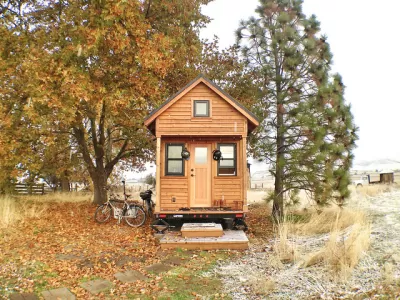People living in tiny homes drastically reduce their ecological footprints and make more sustainable lifestyle choices, research shows.

Maria Saxton reports on her dissertation research about the environmental impacts of people downsizing to tiny houses. She compares the ecological footprints of people before and after they moved into tiny houses by calculating the spatial area needed to support their needs for a year. "I found that among 80 tiny home downsizers located across the United States, ecological footprints were reduced by about 45 percent on average," says Saxton.
In addition, she finds that people’s behaviors became more sustainable in a number of ways after moving into tiny homes:
As a whole, I found that after downsizing people were more likely to eat less energy-intensive food products and adopt more environmentally conscious eating habits, such as eating more locally and growing more of their own food. Participants traveled less by car, motorcycle, bus, train and airplane, and drove more fuel-efficient cars than they did before downsizing.
Based on her survey and interview findings, Saxton also estimates that 366 million acres of resources could be saved if 10 percent of the population downsized to tiny homes. She hopes that this evidence will help support local rezoning efforts to allow tiny homes and the development of sustainable housing.
FULL STORY: When People Move Into Tiny Homes, They Adopt Greener Lifestyles

Planetizen Federal Action Tracker
A weekly monitor of how Trump’s orders and actions are impacting planners and planning in America.

Map: Where Senate Republicans Want to Sell Your Public Lands
For public land advocates, the Senate Republicans’ proposal to sell millions of acres of public land in the West is “the biggest fight of their careers.”

Restaurant Patios Were a Pandemic Win — Why Were They so Hard to Keep?
Social distancing requirements and changes in travel patterns prompted cities to pilot new uses for street and sidewalk space. Then it got complicated.

Platform Pilsner: Vancouver Transit Agency Releases... a Beer?
TransLink will receive a portion of every sale of the four-pack.

Toronto Weighs Cheaper Transit, Parking Hikes for Major Events
Special event rates would take effect during large festivals, sports games and concerts to ‘discourage driving, manage congestion and free up space for transit.”

Berlin to Consider Car-Free Zone Larger Than Manhattan
The area bound by the 22-mile Ringbahn would still allow 12 uses of a private automobile per year per person, and several other exemptions.
Urban Design for Planners 1: Software Tools
This six-course series explores essential urban design concepts using open source software and equips planners with the tools they need to participate fully in the urban design process.
Planning for Universal Design
Learn the tools for implementing Universal Design in planning regulations.
Heyer Gruel & Associates PA
JM Goldson LLC
Custer County Colorado
City of Camden Redevelopment Agency
City of Astoria
Transportation Research & Education Center (TREC) at Portland State University
Camden Redevelopment Agency
City of Claremont
Municipality of Princeton (NJ)


























